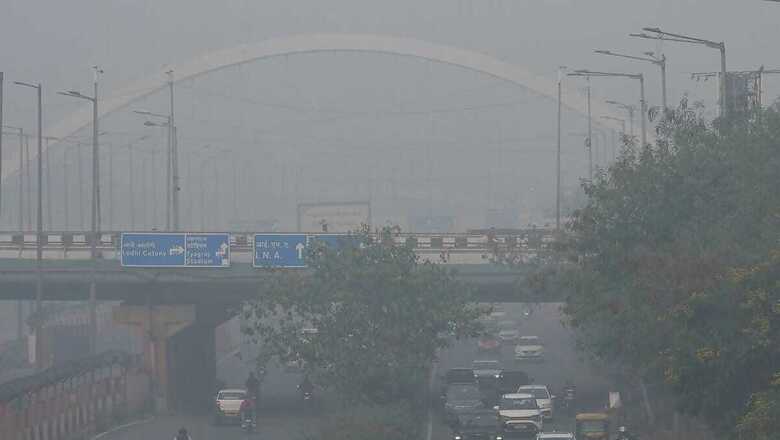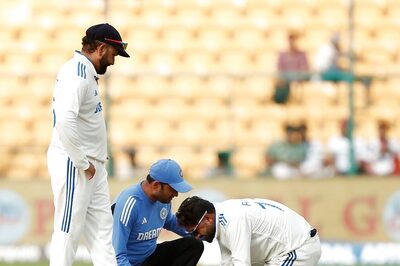
views
Two experimental smog towers cannot be a “practical solution” to Delhi’s acute air pollution as the national capital will need more than 47,000 such giant air purifiers to be effective enough to mitigate the problem, the Delhi Pollution Control Committee has said.
In a report submitted to the National Green Tribunal (NGT) last week, the pollution control body stressed that these costly structures lack merit and the two such existing towers in Delhi should be repurposed for the “dissemination of technical information on air pollution control as a museum”.
One smog tower is installed at Connaught Place under the Delhi Pollution Control Committee (DPCC) while the other one is at Anand Vihar under the Central Pollution Control Board (CPCB). These were installed in 2021 following the Supreme Court’s directions.
According to the report, senior scientist Nandita Moitra of the DPCC said the Rs 25-crore smog tower at Connaught Place, which has been operational for two years, can only mitigate air pollution by up to 17 percent within a 100-metre radius. The report stated that considering the city’s vast area of 1,483 sq km, it will need over 47,000 such towers with each costing Rs 25 crore for installation and requiring Rs 15 lakh per month for operation and maintenance.
The DPCC report further said this is not at all justified and is “not even a drop in the ocean”, when you take into account the high purchase and maintenance costs of this so-called solution. Both towers are experimental and the results are not at all encouraging to incur the heavy expenditure from public funds, it said.
Delhi’s air quality worsened within the severe category on Thursday as unfavourable meteorological conditions hindered the dispersion of pollutants. The 24-hour average air quality index (AQI), recorded at 4 pm every day, stood at 419. It was 401 on Wednesday (November 15), 397 on November 14, 358 on November 13 and 218 on November 12, 220 on November 11 and 279 on November 10.
Last week, central government sources had said smog towers are not a solution to the air pollution problem in Delhi-NCR and the Centre is not in favour of installing more of these. Delhi environment minister Gopal Rai had earlier claimed that the Connaught Place smog tower was temporarily shut down due to “unilateral” directions issued by DPCC’s Ashwani Kumar. But, it was again made operational last week following SC directions.
According to CPCB data, the smog tower at Anand Vihar reduced PM2.5 concentration by up to 17 percent and PM10 pollution levels by up to 27 percent in a 100-metre radius during the 2021-22 winter season. The Delhi government said last year that the Connaught Place smog tower could reduce air pollution by 70 to 80 percent within a radius of 50 m and by 15 to 20 percent up to 300 m.
Vehicular emissions, secondary inorganic aerosols main culprits
A study under a joint project of the Delhi government and IIT-Kanpur found that vehicular emissions accounted for about 38 percent of the pollution on Wednesday (November 15). This reduced to 25 percent in the next 24 hours.
Secondary inorganic aerosols – particles such as sulfate and nitrate formed in the atmosphere due to the interaction of gases and particulate pollutants from sources like power plants, refineries, and vehicles – is the second major contributor to foul air, accounting for 30 to 35 percent of the air pollution over the past few days.
A system developed by the Pune-based Indian Institute of Tropical Meteorology (IITM) showed stubble burning accounted for 7.5 percent of the air pollution on Thursday. It is likely to come down to 3.5 percent on Friday (November 17) and 3 percent on November 18. A DPCC analysis, however, shows that Delhi experiences peak pollution from November 1 to 15 when the number of stubble-burning incidents in Punjab and Haryana increases. On Thursday, Punjab reported 1,271 stubble burning incidents, taking the total number of such fires to 31,932 since September 15.
The India Meteorological Department (IMD), meanwhile, said calm winds and low temperatures are allowing accumulation of pollutants and relief is unlikely over the next few days. However, an improvement in the wind speed from November 21 might bring pollution levels down.
The air quality has worsened over the past few days despite stringent measures, including a ban on construction work and the entry of diesel-guzzling trucks. According to IQAir, a Swiss company that specialises in air quality monitoring, Delhi was the most polluted city in the world on Thursday followed by Baghdad and Lahore.
Six-member special task force to implement GRAP
A six-member special task force (STF) has been set up to ensure strict implementation of measures outlined in the Graded Response Action Plan (GRAP), Rai said. Delhi special secretary (environment) will head the STF whose members include senior officials from the departments of transport, traffic, revenue, Municipal Corporation of Delhi (MCD) and public works department (PWD).
The environment minister said the STF will coordinate with all the departments involved and submit a daily report to the Delhi government. Earlier in the day, he held a meeting with departments on the effective implementation of anti-pollution measures.
Rai had previously reprimanded the departments concerned for their negligence in executing the GRAP and urged them to establish a monitoring mechanism. Strict restrictions, including a ban on construction work and the entry of polluting trucks into the capital, under the GRAP’s final stage kicked in on November 5 as the AQI dipped to “severe plus” (above 450).
Buses except CNG, electric, BS-VI diesel to be barred
There is likely to be a complete ban on passenger buses except those running on CNG, electricity and BS-VI diesel from entering Delhi. Restrictions under GRAP Stage IV are in place and, at present, only trucks are barred from entering the city.
A source said, “Chhath Puja is around the corner and there is a huge rush being witnessed because of it. We are planning to implement a ban after the festival.”
Last month, the Delhi government directed that all buses entering the national capital from Haryana will have to be run on electricity, CNG or BS-VI diesel. Buses entering from the NCR regions of Uttar Pradesh and Rajasthan also need to follow these norms. “There are plans to implement the same norms for buses coming from all states,” the source said.
(With PTI inputs)














Comments
0 comment